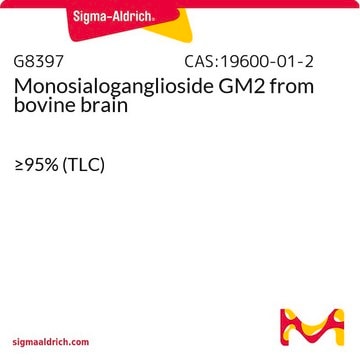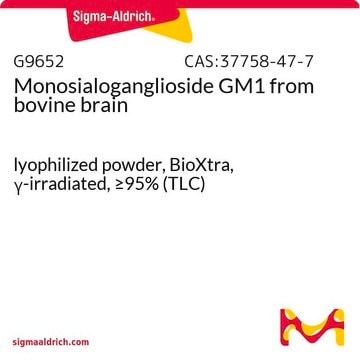G9398
Asialoganglioside-GM2 from bovine brain
~95%, lyophilized powder
Synonym(s):
GA2 Ganglioside, Gangliotriosyl ceramide
Sign Into View Organizational & Contract Pricing
All Photos(1)
About This Item
Recommended Products
General description
Gangliosides are major constituents of neuronal cell membranes and endoplasmic reticulum; contain a sialated polysaccharide chain linked to ceramide through a β-glycosidic linkage; for classification of gangliosides see Svennerholm, L., et al. (eds.), Structure and Function of Gangliosides, New York, Plenum, 1980.
Biochem/physiol Actions
Degraded form of Asialoganglioside-GM1 ganglioside.
Storage Class
11 - Combustible Solids
wgk_germany
WGK 3
flash_point_f
Not applicable
flash_point_c
Not applicable
ppe
Eyeshields, Gloves, type N95 (US)
Certificates of Analysis (COA)
Search for Certificates of Analysis (COA) by entering the products Lot/Batch Number. Lot and Batch Numbers can be found on a product’s label following the words ‘Lot’ or ‘Batch’.
Already Own This Product?
Find documentation for the products that you have recently purchased in the Document Library.
Christian H Schweppe et al.
Journal of lipid research, 51(8), 2282-2294 (2010-05-07)
Shiga toxin (Stx)-producing Escherichia coli are the leading cause of hemorrhagic colitis and life-threatening extraintestinal complications in humans. Stx1 and Stx2 are transferred by yet to be delineated mechanisms from the intestine to the circulation where they injure microvascular endothelial
W Möbius et al.
The journal of histochemistry and cytochemistry : official journal of the Histochemistry Society, 47(8), 1005-1014 (1999-07-29)
A radioactive and biotin-labeled analogue of GM1 (biotin-GM1) was synthesized which enabled us to analyze its intracellular distribution in the compartments of the endocytic route by electron microscopic immunocytochemistry using thin sections of human skin fibroblasts labeled with gold-conjugated antibiotin
Annelies Coddens et al.
PloS one, 6(9), e23309-e23309 (2011-09-29)
Enterotoxigenic F4-fimbriated Escherichia coli is associated with diarrheal disease in neonatal and postweaning pigs. The F4 fimbriae mediate attachment of the bacteria to the pig intestinal epithelium, enabling an efficient delivery of diarrhea-inducing enterotoxins to the target epithelial cells. There
Aufaugh Emam et al.
Microbiology (Reading, England), 152(Pt 9), 2789-2799 (2006-09-02)
The glycosphingolipids (GSLs) gangliotriaosylceramide (Gg(3)) and gangliotetraosylceramide (Gg(4)) have been implicated as receptors for type IV pili (T4P)-mediated Pseudomonas aeruginosa epithelial cell attachment. Since P. aeruginosa T4P are divided into five groups, the authors determined whether GSLs in general, and
K Kanai et al.
The Southeast Asian journal of tropical medicine and public health, 28(4), 781-790 (1998-07-10)
Specific binding between bacterial cells and host tissue is an early step of the pathogenesis of infection. Burkholderia pseudomallei cells, the causative micro-organisms of melioidosis, were demonstrated to bind specifically to tissue glycolipids (asialo GM1 and asialo GM2) by solid
Our team of scientists has experience in all areas of research including Life Science, Material Science, Chemical Synthesis, Chromatography, Analytical and many others.
Contact Technical Service








